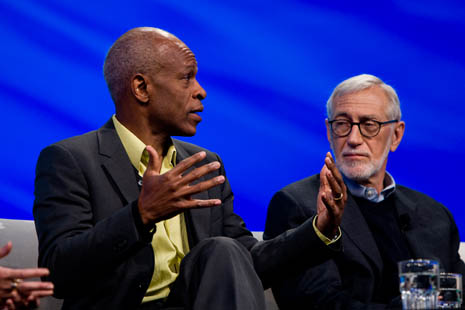Look out, planners. Landscape architects are out to eat your lunch. Managing Editor Tim Halbur reports from the 2011 ASLA Annual Meeting and Expo in San Diego, where a movement towards better urbanism is hoping to balance a history of design-driven practice.
"We're getting a larger and larger voice, and we're beginning to take the lead on projects," says Shane Cohen, a landscape architect with coen + partners. Throughout my visit at the 2011 American Society of Landscape Architects' Annual Meeting and Expoin San Diego last week, I heard about the growing role of landscape architects in shaping the built environment. No longer satisfied to plant drought-resistant local fauna in the spaces between the buildings, landscape architects are blurring the lines and taking charge of teams of planners and architects on major projects around the world.
"Our voice is getting stronger and stronger," continued Cohen, "And we're being listened to. One of our responsibilities is to know the best team to put together to ensure projects are done with the most integrity."

Blame The High Line, the project driven by James Corner Field Operations, for presenting a vision of how an LA-led project can be successful. Today, even though construction is stalled across the country, landscape architects are finding work on smaller, in-between spaces and driving megaprojects in China and elsewhere. "Landscape Architecture Rising" was the slogan of the event, and with an impressive turnout and a massive exhibition floor, it certainly appears that landscape architects are growing in importance.
LAs are also stealing planners' thunder when it comes to the importance of public participation and community engagement. "I think we have a really valuable skill set," said Former Charlottesville mayor Maurice Cox, sitting on a panel of famed landscape architects. "But it does require you be incredibly close to decision makers, and you have to be at that community meeting."
Famed landscape architect Laurie Olin echoed the thought that community buy-in is essential, and added that landscape architecture as a field doesn't have a point of view. "We're agents of change, but we have to decide what kind of change we want," said Olin. "We give form to change, but we don't often drive it ourselves. We say, 'aha, here's an opportunity to give this idea form and expression,' but it's not our idea. For a long time, the problem in cities was that we would just solve one problem at a time, like moving cars faster. But every project has to do with wastewater management, and community engagement and children."

Perhaps the most outspoken member of the panel (given that Andrés Duany was a no-show), Martha Schwarz spoke adamantly about the power of design to do the heavy lifting when it comes to revitalizing cities. "I don't think there are enough big ideas," she said, pushing back on moderator John King's question about the danger of thinking big. "Cities need iconic sites, because they are in direct competition with each other. The problem is that people are not educated more fully about what design can do."
I left the panel energized, ready to believe that landscape architecture is indeed a partner of planning, and the lines drawn over the past century between the fields after are destined to fade. But the next session I attended, presenting the work of the aforementioned firm cohen + partners, created serious doubts in my mind. Slide after slide showed stark minimalist plazas, beautiful but baldly anti-urban. One slide showed part of the firm's work on the adjacent streets around Westminster Presbyterian Church in downtown Minneapolis. It showed a woman posed as if walking down a narrow, block-long passageway framed by white stone walls: an alley that directly violates the planning standard of "eyes on the street" and therefore one which few women (and men, for that matter) are likely to deem safe in the midst of an urban downtown neighborhood. Another project in small-town Minnesota showed two detached garages side-by-side at the end of two parallel driveways. "Here, the only entrance into the house is through the detached garages," explained firm owner Shane Cohen. My heart sank.
Leaving the session, I wandered through the extensive Expo hall, surrounded by sprinkler systems, park benches and sparkly glass gravel alternatives. Landscape architects may be ascendant when it comes to the built environment, but it will have to contend with a field that is split between artistic expression and practical, engaging environments for human beings.
Tim Halbur is managing editor of Planetizen.

Trump Administration Could Effectively End Housing Voucher Program
Federal officials are eyeing major cuts to the Section 8 program that helps millions of low-income households pay rent.

Planetizen Federal Action Tracker
A weekly monitor of how Trump’s orders and actions are impacting planners and planning in America.

The 120 Year Old Tiny Home Villages That Sheltered San Francisco’s Earthquake Refugees
More than a century ago, San Francisco mobilized to house thousands of residents displaced by the 1906 earthquake. Could their strategy offer a model for the present?

HSR Reaches Key Settlement in Northern California City
The state’s high-speed rail authority reached an agreement with Millbrae, a key city on the train’s proposed route to San Francisco.

Washington State Legislature Passes Parking Reform Bill
A bill that would limit parking requirements for new developments is headed to the governor’s desk.

Missouri Law Would Ban Protections for Housing Voucher Users
A state law seeks to overturn source-of-income discrimination bans passed by several Missouri cities.
Urban Design for Planners 1: Software Tools
This six-course series explores essential urban design concepts using open source software and equips planners with the tools they need to participate fully in the urban design process.
Planning for Universal Design
Learn the tools for implementing Universal Design in planning regulations.
Ada County Highway District
Clanton & Associates, Inc.
Jessamine County Fiscal Court
Institute for Housing and Urban Development Studies (IHS)
City of Grandview
Harvard GSD Executive Education
Toledo-Lucas County Plan Commissions
Salt Lake City
NYU Wagner Graduate School of Public Service




























